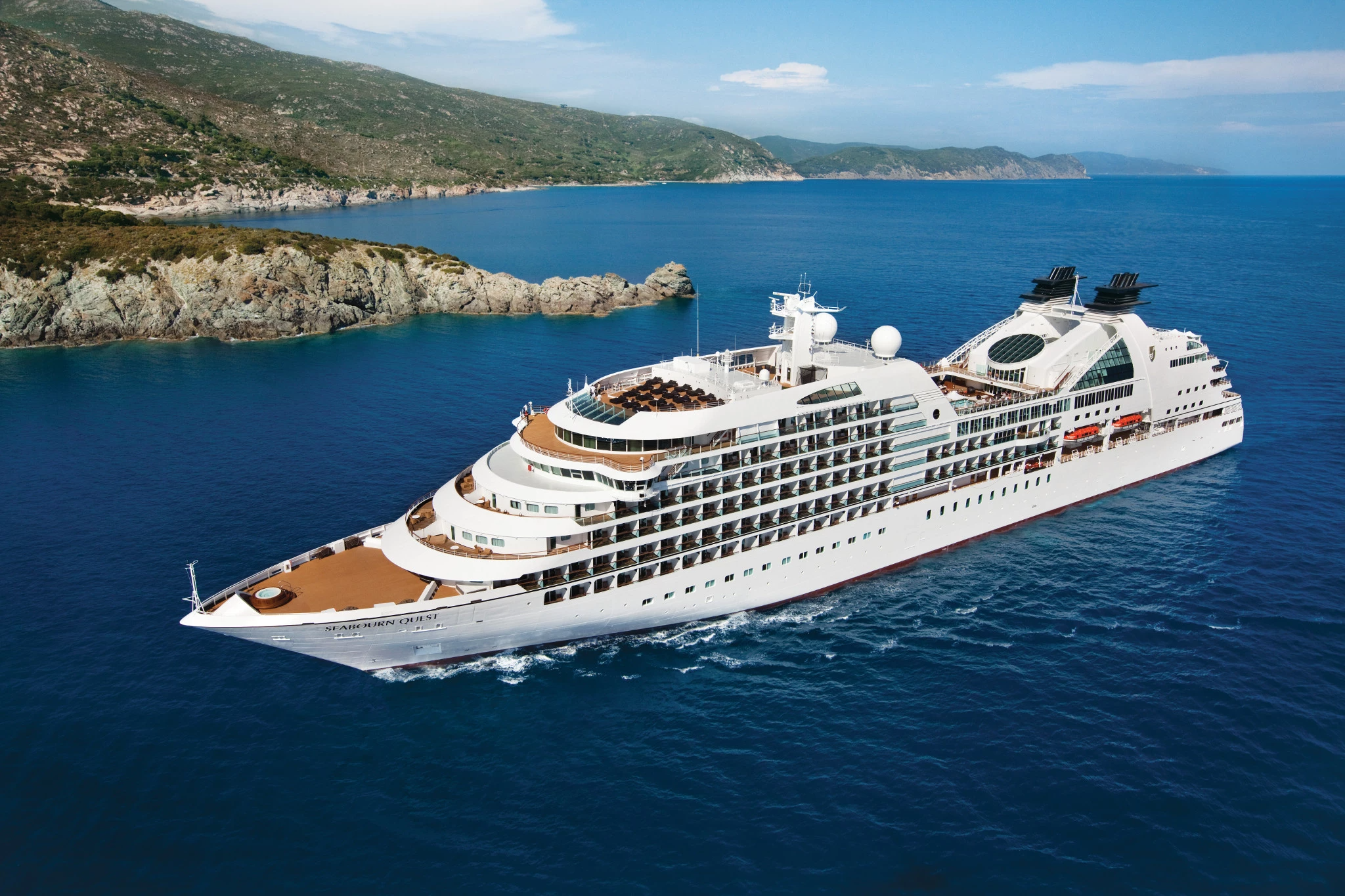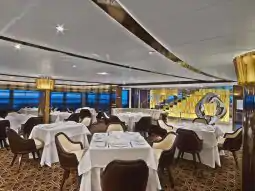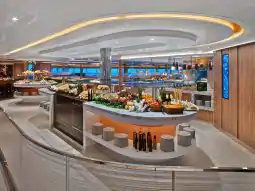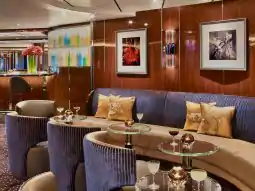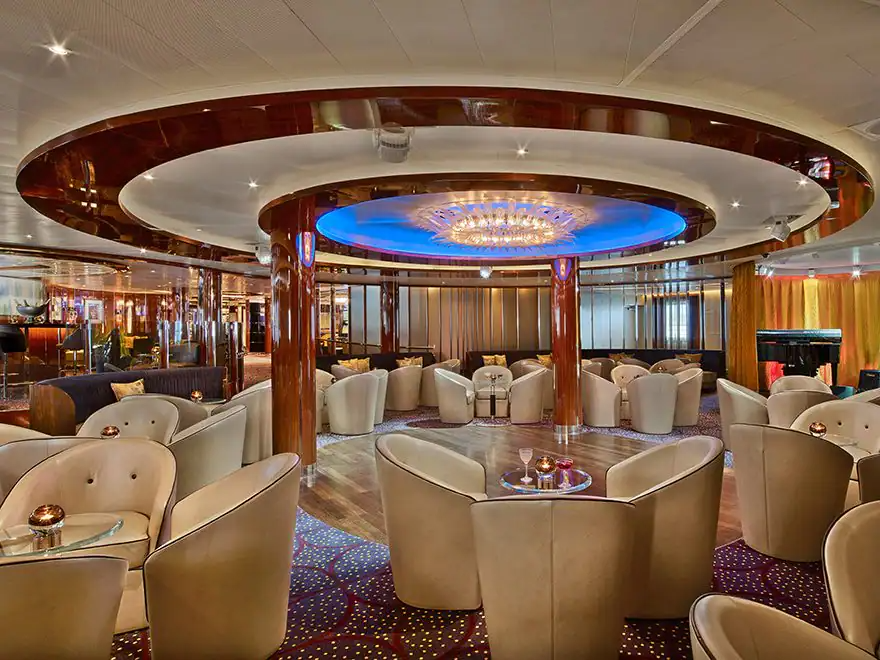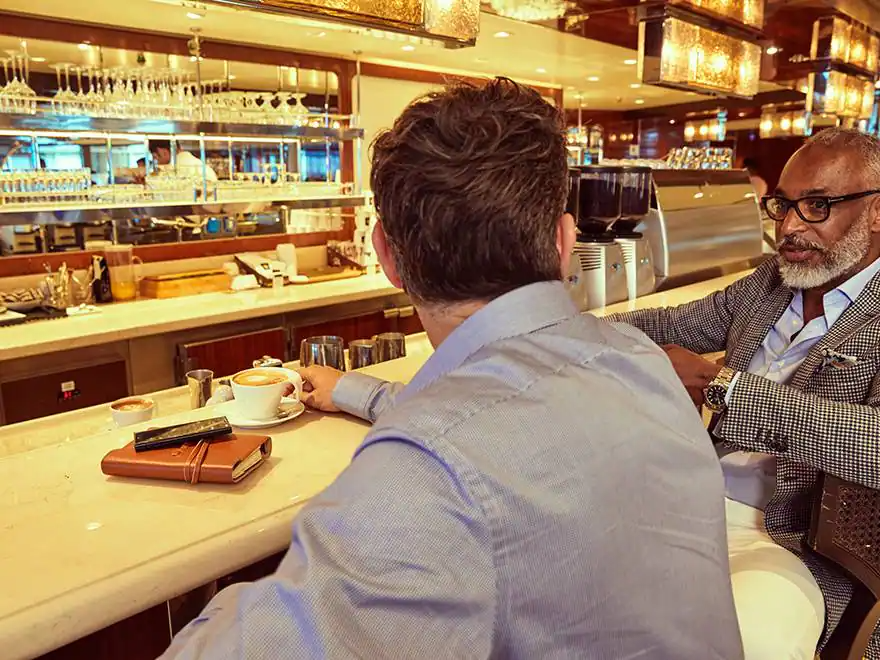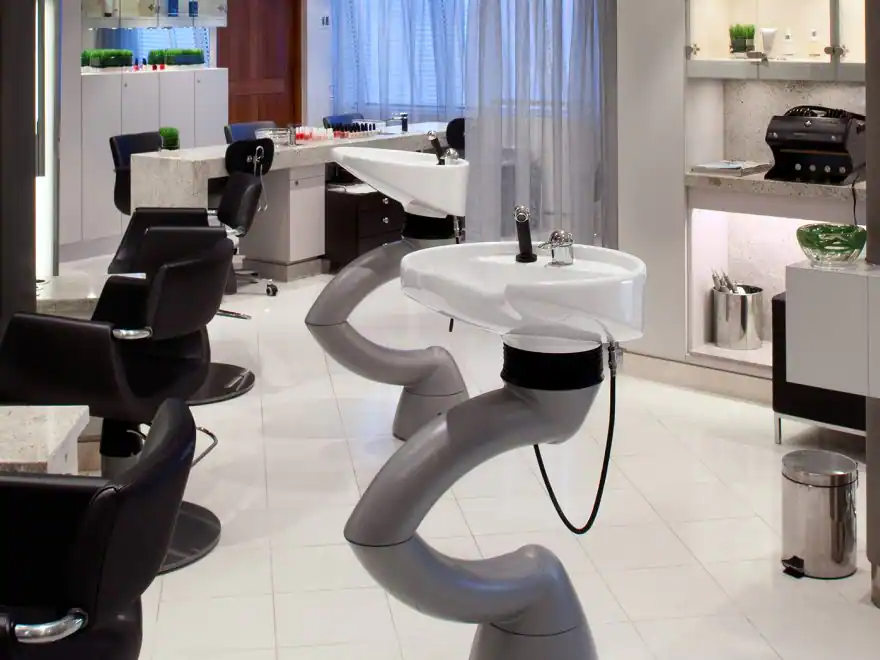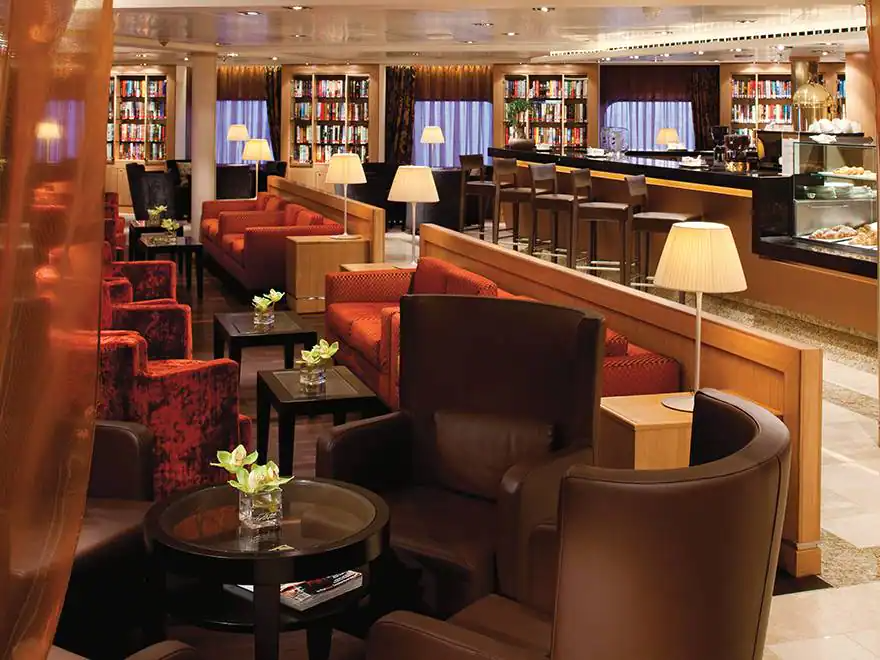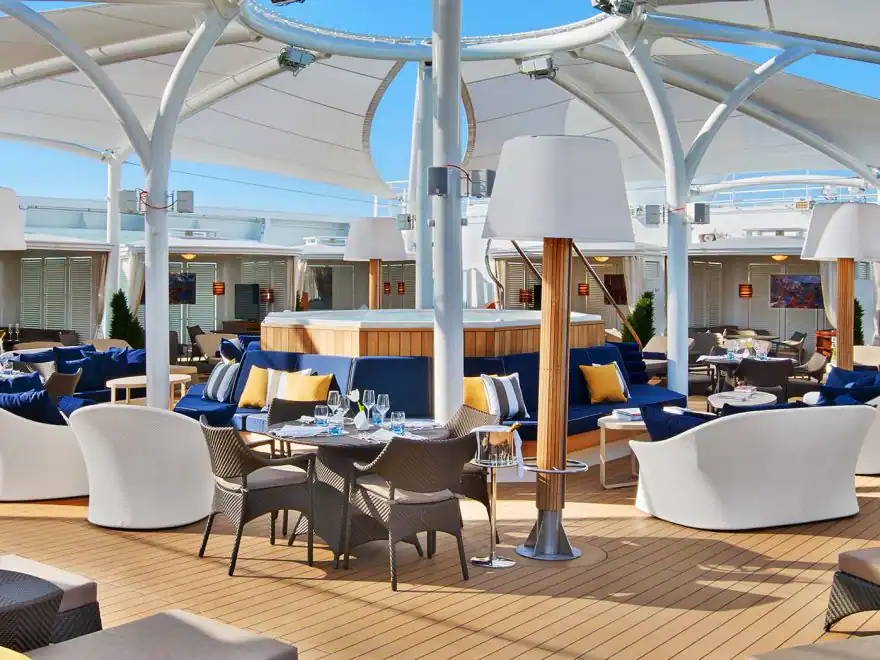*Exclusief Calamiteitenfonds à € 2.50 per reservering en SGR bijdrage à € 5,- per persoon.
Uw vaarschema
Hong Kong is divided into four sections: Hong Kong Island, Kowloon, the New Territories, and the numerous outlying islands. One hundred sixty-four square miles of dense real estate dominate Hong Kong Island, including enormous skyscrapers with futuristic architecture, opulent hotels, residential compounds on Victoria Peak, and some of the oldest Chinese communities in the region. All these elements create one of the most exotic and exciting ports of call in the world; one that is universally loved by tourists and its own enterprising citizens.
Keelung is the second largest port in Taiwan, and a booming trade industry has turned it into a very prosperous city and international seaport. However, the main reason for calling here is to travel inland to visit the contemporary metropolis of Taipei. Not long ago, the scenic valley of the Tanshui River was home to rice and vegetable farmers, but today it is the site of Taiwan’s bustling center of culture, commerce and government.
Closer to Taiwan than to Japan’s main islands, the Yaeyama group is a volcanic archipelago known (though not widely) for its coral reefs and clear waters. Ishigaki is the main hub, and attracts mostly Japanese visitors with inside information about the Caribbean-like appeal of the place. A part of the Okinawa Prefecture, the island is ringed by beaches that vary from sandy expanses to whole strands made up entirely of broken, bleached and tumbled coral. The land itself is mostly given over to palm forests and pineapple plantations. Capes such as Hirakubozaki on the west side, or Uganzaki at the northern tip, are marked by lighthouses and offer nice views. At Kabira Bay no swimming is allowed, due to culture of black pearls, but glass-bottom boats offer views of the colorful sea life. Other beaches welcome snorkelers, swimmers and windsurfers.
“Naha, de hoofdstad en de grootste stad van de prefectuur Okinawa in Japan, dient ook als het belangrijkste politieke, economische en transportcentrum van de regio. Met een fascinerend verleden als hoofdstad van het Koninkrijk Riukiu en een functionerende haven die dateert uit de 15e eeuw, slaagt deze stad van 300.000 inwoners erin om zowel een boeiende als een relaxte stad te zijn.
Omdat de stad tijdens de Tweede Wereldoorlog grotendeels werd verwoest, zijn er hier niet veel oude gebouwen; toch hebben een paar gerestaureerde overblijfselen uit het tijdperk van het Koninkrijk Riukiu wel historisch belang, waaronder Shuri Castle, het koninklijk paleis en zijn buitengewone tuinen. Beide zijn toegevoegd aan een lokale groep die gezamenlijk staan vermeld op de Werelderfgoedlijst van UNESCO. Andere legendarische locaties zijn onder andere het Koninklijk Mausoleum (graftombes in grotten) en de Shurei Gate, die zo prachtig is dat de afbeelding wordt weergegeven op het 2.000-yenbiljet.
Er zijn ook enkele moderne hotspots, namelijk Kokusai Street, met bijna twee kilometer (1.25 mijl) aan winkels, cafés en restaurants, en de nabijgelegen Makishi openbare markt, waar tientallen voedselverkopers heerlijke lekkernijen aanprijzen. Als u er verder weg opuit wilt, is Naha het ideale startpunt voor excursies naar de rest van Okinawa.”
“Jeju, dat vroeger Cheju heette, is voor de meesten van ons onbekend terrein, maar voor Koreaanse reizigers is het een populaire bestemming, aangezien dit het grootste eiland van het land is en de thuishaven van 12 Werelderfgoederen van UNESCO. Het eiland is ruwweg even groot als Maui en heeft veel gemeen met de Hawaïaanse eilanden. Ook dit eiland is een vulkanisch eiland, het verrees zo’n twee miljoen jaar geleden uit de zee en de vulkaan Hallasan, die een hoogte van 1950 meter bereikt, is de hoogste bergtop van Zuid-Korea. Ook heerst er hetzelfde subtropische klimaat als op Hawaï – zelfs in de winter vriest het er haast nooit – en u vindt er een even groot aanbod activiteiten, bijvoorbeeld in het warme oceaanwater of het verkennen van het binnenland over de duidelijk gemarkeerde en goed verzorgde wandelpaden.
Jeju staat al eeuwenlang bekend als ‘Eiland van de goden’. De eilandbewoners zouden afstammen van een legendarisch, verloren ras. Misschien helpt deze geschiedenis de super-menselijke verrichtingen te verklaren van de haenyeo, duikende vrouwen die zeeoren oogsten vanaf de zeebodem zonder duikuitrusting. Hier kunnen opmerkelijke reuzen gespot worden, aangezien er veel bultruggen en orka’s voorkomen in dit deel van de Oost-Chinese Zee.”
Busan is the second largest city in South Korea, and the country’s seaside connection to Japan and the West. Lovely urban scenery, the Pusan International Film Festival, and near-by hot springs has made Busan a popular leisure destination. Busan has the sophistication of a major city, as well as famous beaches that lure visitors from all over the world. The city is a microcosm of South Korea, a nation whose economic success often obscures, to Westerners, one of Asia’s most sophisticated and venerable cultures.
Kitakyushu is the northernmost city on Japan’s Kyushu Island. Kokura Castle is surrounded by Katsuyama Park, known for its spring cherry blossoms. Riverwalk Kitakyushu is a shopping mall by the Murasaki River. Northeast, Moji Port Retro Area has 1900s buildings, like the red-brick Moji Customs Building and striped Old Mitsui OSK Line Building. Vintage locomotives are displayed at the Kyushu Railway History Museum.
Takamatsu is located on Shikoku, the smallest of Japan’s four main islands, in the Kagawa Prefecture on the Seto Inland Sea. During the Edo period, it was famous for its seaside castle, one of the few with a moat utilizing seawater. The castle was destroyed during the Meiji period, and today the so-called Sunport waterfront project has substituted the Symbol Tower, Takamatsu’s tallest building, for the castle tower that once graced its flag. Long an important port for Japan, Takamatsu was nearly destroyed in 1945 by Allied incendiary bombing. A portion of the famous castle, including foundations and part of the wall, still strand on the city-center park, and there are plans to reconstruct more of it. The Ritsurin Koen garden, first built in the Edo period, survives, and makes a welcome oasis in the city, with a folk museum, rest houses and a tranquil tearoom among lakes, hills and groves of cherry trees that bloom in the spring and flame into color in the autumn. The Shikoku Mura is an open-air museum with traditional buildings gathered from all over Shikoku on display. The Yashima area boasts an Isamu Noguchi Museum dedicated to the late designer, artist and sculptor, with several traditional buildings he relocated and used as work spaces and galleries, along with many finished and unfinished sculptures. There is also a lovely Yashima Temple halfway up the mountain, and at the top, an observation deck with breathtaking views of the city and port.
Kobe has been an important port city for many centuries, and was one of the first Japanese ports to be opened to foreign trade in the late Edo Period. Today, Kobe is one of Japan’s ten largest cities. Sustaining heavy damage from the devastating Great Hanshin Earthquake of 1995, the city has fully recovered, and remains one of Japan’s more cosmopolitan cities. A typical Japanese harbor town, foreign culture was introduced here centuries ago, and Kobe’s food and architecture posses a diverse and exotic flavor.
Shimizu, dat over het algemeen wordt beschouwd als een van de mooiste havens van Japan, biedt op een heldere dag een ongeëvenaard uitzicht op Mount Fuji en heeft het mooiste Miho-no-Matsubara pijnbomenbos op de achtergrond (beide staan op de werelderfgoedlijst van UNESCO). Het milde klimaat van de haven en de rijke cultuur, zeer verbonden met de omliggende Shizuoka-regio, maken het tot een van de beste bestemmingen van het land om te gaan bekijken. Een aantal van de belangrijkste bezienswaardigheden zijn Kunozan Toshogu Shrine, door de Japanse overheid bestempeld tot nationaal erfgoed, Sumpu Castle (gebouwd in 1586) en Shizuoka Sengen Shrine, waar de krijgsheer Tokugawa Ieyasu, die regeerde in de Edo-periode, zijn volwassenwordingsceremonie hield. De shoguns van Tokugawa regeerden Japan 250 jaar, tot 1867. De hele regio biedt voldoende pittoreske kustlandschappen, theeplantages en een rijkdom aan Boeddhistische tempels en Shinto-altaren, terwijl de haven zelf, beroemd in de twintigste eeuw vanwege de thee-export, vandaag de dag het meest bekend is om de wonderbaarlijke tonijnvangst; de grootste in Japan. In de vele fantastische restaurants in de haven kunt u hiervan proeven, samen met andere lokale heerlijkheden zoals sakura shrimp en shirasu (jonge haring).
“Tot het midden van de 19e eeuw was Japan geïsoleerd, afgesloten van de rest van de wereld. Yokohama was niet meer dan een vissersdorp. Maar in 1853 eiste de Amerikaanse marineofficier Matthew Perry dar het land openging voor buitenlandse handel, en Yokohama werd voor altijd veranderd. De stad ontpopte zich al snel tot een internationaal handelscentrum, en terwijl hij vandaag de dag vaak wordt overschaduwd door Tokio, blijft hij een van Japan’s levendigste, internationale bestemmingen. In Yokohama vindt u diverse microbrouwerijen en restaurants met een internationale kaart. De stad is echt anders dan vele andere Japanse steden.
Vanuit Yokohama bent u snel in het rustige Kamakura, waar de op twee na grote bronzen Boeddha van Japan staat en waar zich het belangrijke Shinto-heiligdom Tsurugaoka Hachimangu bevindt. Ga naar het nationaal park Hakone op een onbewolkte dag en u zult beloond worden met prachtig uitzicht op de majestueuze berg Fuji.”
Hiroshima means “wide island” in Japanese. The city was established in the 16th Century on Japan’s largest island, Honshu, and grew into an important shipping center and prefecture capital, boasting a fine castle. Although it was an important city in Japan throughout the imperial period, its reputation in the greater world was burned into history when it became to target of the first atomic bombing of a civilian target in August of 1945. The United States airplane Enola Gay dropped a nuclear device nicknamed “Little Boy” on the city that morning, obliterating everything within a two-kilometer radius and directly killing 80,000 people. Approximately 70 percent of Hiroshima’s buildings were destroyed. Within a year, injury and radiation illness had killed an additional 90, 000 to 116,000 citizens. The attacks on Hiroshima and nearby Nagasaki quickly led to the surrender of Japan and effectively precipitated the end of World War II in Asia. Within a few years, Hiroshima had begun to rebuild, and the city became the focus of an international movement to eliminate nuclear weapons from future wars. Relics of its past such as the impressive Hiroshima Castle and the tranquil Shukkeien Garden were rebuilt, and the city undertook the construction of a Memorial Peace Park, which today attracts visitors from around the world. The park, which holds a museum and a memorial “Atomic Dome” constructed on the closest remaining building to the blast site, is a moving and impactful place of pilgrimage in this re-born City of Peace. One notable feature is a colorful memorial to Sadako Sasaki, a young woman whose dying wishes for world peace were recounted in the story A Thousand Paper Cranes.
Hiroshima means “wide island” in Japanese. The city was established in the 16th Century on Japan’s largest island, Honshu, and grew into an important shipping center and prefecture capital, boasting a fine castle. Although it was an important city in Japan throughout the imperial period, its reputation in the greater world was burned into history when it became to target of the first atomic bombing of a civilian target in August of 1945. The United States airplane Enola Gay dropped a nuclear device nicknamed “Little Boy” on the city that morning, obliterating everything within a two-kilometer radius and directly killing 80,000 people. Approximately 70 percent of Hiroshima’s buildings were destroyed. Within a year, injury and radiation illness had killed an additional 90, 000 to 116,000 citizens. The attacks on Hiroshima and nearby Nagasaki quickly led to the surrender of Japan and effectively precipitated the end of World War II in Asia. Within a few years, Hiroshima had begun to rebuild, and the city became the focus of an international movement to eliminate nuclear weapons from future wars. Relics of its past such as the impressive Hiroshima Castle and the tranquil Shukkeien Garden were rebuilt, and the city undertook the construction of a Memorial Peace Park, which today attracts visitors from around the world. The park, which holds a museum and a memorial “Atomic Dome” constructed on the closest remaining building to the blast site, is a moving and impactful place of pilgrimage in this re-born City of Peace. One notable feature is a colorful memorial to Sadako Sasaki, a young woman whose dying wishes for world peace were recounted in the story A Thousand Paper Cranes.
Busan is the second largest city in South Korea, and the country’s seaside connection to Japan and the West. Lovely urban scenery, the Pusan International Film Festival, and near-by hot springs has made Busan a popular leisure destination. Busan has the sophistication of a major city, as well as famous beaches that lure visitors from all over the world. The city is a microcosm of South Korea, a nation whose economic success often obscures, to Westerners, one of Asia’s most sophisticated and venerable cultures.
Deze slaperige kleine havenstad herbergt het intieme Kehi-heiligdom, met zijn roodgelakte Torii-poort en koi-vijver. Kom meer te weten over de fascinerende geschiedenis van de stad in het Tsuruga Museum. Eet gegrilde zeevruchten net als de lokale inwoners bij Nihonkai Sakana Machi.
Toyama is a coastal city on Japan’s main island, Honshu. In the center, Toyama Castle Park has a restored castle dating to the 1500s, plus small museums of history and art. The nearby Toyama Glass Art Museum displays striking contemporary works. Rakusui-tei is an art museum in a traditional home with a formal garden. On the Fugan Canal, Kansui Park has views of the distant Tateyama mountains.
Sakata is a city on the northwest coast of Japan’s Honshu Island. In the center, Sankyo Soko is a group of warehouses built in 1893. One now contains the Historical Museum of Shonai Rice. The Honma Museum of Art includes antiques displayed in a 19th-century villa. The Ken Domon Museum of Photography is dedicated to the revered social realist photographer. North of the city, trails lead to up Mount Chōkai volcano.
This important port on Japan’s northern Hokkaido Island was the first to be opened to European and American trade. The result of this is a trove of Western-style buildings in the suburb of Motomachi that gives the impression of a movie set. The bell of the distinctive Haristo Greek Orthodox church is designated one of Japan’s official treasured “100 soundscapes.” Hokkaido is famous for its hot springs, much beloved by the Japanese. Yunokawa Hot Spring enjoys a commanding view of the sea, and its botanical garden is home to the Japanese macaques called “snow monkeys” because of their habit of soaking in the hot springs during the northern winter. Goryokaku is a 150-year old star fortress that holds the Magistrate’s Office, an excellent example of traditional Japanese architecture. Get a panoramic view from the observation platform atop the Goryokaku Tower.
Blessed by a protective range of mountains and a relatively warm ocean current, Kushiro gets less than a third of the winter snow of its Hokkaido neighbor Sapporo, and twice as much sunshine as the nearby Kuril Islands. Thus it is an important reliably ice-free port during the winter. Like all of Japan, it is riddled with semi-active geothermal features and occasionally rattled by tremors. Scenic Lake Akan is ringed by hot springs. It also has an Ainu Koten museum with a replica village and folklore performances of the indigenous Hokkaido people. The Japanese Crane Reserve is a good place to see breeding populations of these large and graceful birds, so respected by the Japanese. The city encompasses Japan’s largest wetland, and the Kushiro City Marsh Observatory has a boardwalk to see it, as well as the Fureai Horse Park which offers equestrian tours into the forest.
“Tot het midden van de 19e eeuw was Japan geïsoleerd, afgesloten van de rest van de wereld. Yokohama was niet meer dan een vissersdorp. Maar in 1853 eiste de Amerikaanse marineofficier Matthew Perry dar het land openging voor buitenlandse handel, en Yokohama werd voor altijd veranderd. De stad ontpopte zich al snel tot een internationaal handelscentrum, en terwijl hij vandaag de dag vaak wordt overschaduwd door Tokio, blijft hij een van Japan’s levendigste, internationale bestemmingen. In Yokohama vindt u diverse microbrouwerijen en restaurants met een internationale kaart. De stad is echt anders dan vele andere Japanse steden.
Vanuit Yokohama bent u snel in het rustige Kamakura, waar de op twee na grote bronzen Boeddha van Japan staat en waar zich het belangrijke Shinto-heiligdom Tsurugaoka Hachimangu bevindt. Ga naar het nationaal park Hakone op een onbewolkte dag en u zult beloond worden met prachtig uitzicht op de majestueuze berg Fuji.”
Seabourn Quest
Seabourn Quest ist die dritte Weiterentwicklung eines Schiffdesigns, das als „bahnbrechend im Luxussegment“ bezeichnet wurde. Gebaut in der Werft T. Mariotti in Genua wurde das Schiff am 20. Juni 2011 in Barcelona getauft. Getreu der Seabourn-Tradition befinden sich an Bord all ihrer Reisen um die Welt immer auch eine Vielzahl von preisgekrönten Restaurants, die den erlesensten Restaurants weltweit in nichts nachstehen. Die Seabourn Quest bietet eine Vielzahl von Speisemöglichkeiten für jeden Geschmack und jede Stimmung, und immer ohne Aufpreis.
Casino
Entertainmentteam
Gaming Club Casino
Theater
Woonkamer
Winkelcentrum
Internet Cafe
Mini golf, 9 holes
Ruimte om te kaarten
Bibliotheek
Water Sports Marina
Greenhouse Spa & Salon
Massage
Spa
Zwembad
Bubbelbad(en)
Bar
Mariners Patio Bar
Patio Grill
Patio Lounge
Sky Bar
The Colonnade
The Grill (burgers & hot dogs)
The Restaurant
The Restaurant 2
Fitnesscentrum
Sportschool
Wellnesscentrum / spa


